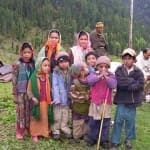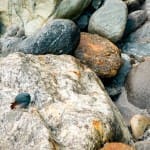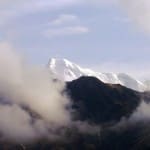In Wan, Jennifer Nandi marvels at the great Himalayan night that has no trouble falling, and laments how so many city-dwellers look skyward and never see the stars
 |
| The guest house at Wan adjoins a grove of some of the tallest deodars in all of Uttarakhand |
The village of Wan is spread widely along the sides of the valley; its fields of spring wheat, potatoes, spinach, and radish envelop the mud-and-stone houses in a seamless web. The village track cuts through a hillside bordered by scrub from which Brownish-flanked Bush warblers sing loud and clear. Groves of newly leafed walnut trees shade every water point. We rest under the splendour of these trees. The men march onwards to Wan but Sunita and I have no inclination to arrive at the Rest House early. We linger around thickets and watch the female of a Slaty-blue Flycatcher. The odious Devidutt goads us on but we ignore him. He can’t wait to reach our destination where he can jettison us and head for the nearest bar. I have just finished thinking the worst of him when we are besieged by children who importune us and it is Devidutt, the scrounge, who sits on his haunches, gathers the little waifs around, and soothes them with pieces of biscuits that he had saved. And I am so ashamed of myself.
Ahead, a weather-beaten sign tells us we have reached the Forest Rest House of Wan. Old cypress trees clothe the hillside, obscuring our view of tonight’s campsite. Amidst the grove is an ancient tree lying on its side, still smouldering. An act of vandalism? Who knows? More importantly, who cares? While we should be raging against this tragedy, we silently mourn its loss. How quickly one becomes inured to an outrageous wrong.
To enter the compound, one must hoist one’s weary self up and over a four-foot stone-wall! There is no electricity, little water, but we get to sleep in a proper bed tonight even if we must share the room with everybody else. There is neither chowkidar nor cook but our fellow-trekkers are chatting with some very nice-looking young men of foreign origin. In all my twenty-five years of trekking in the Himalaya, I have encountered few Indian trekking enthusiasts; fewer who trek with some knowledge of natural history.
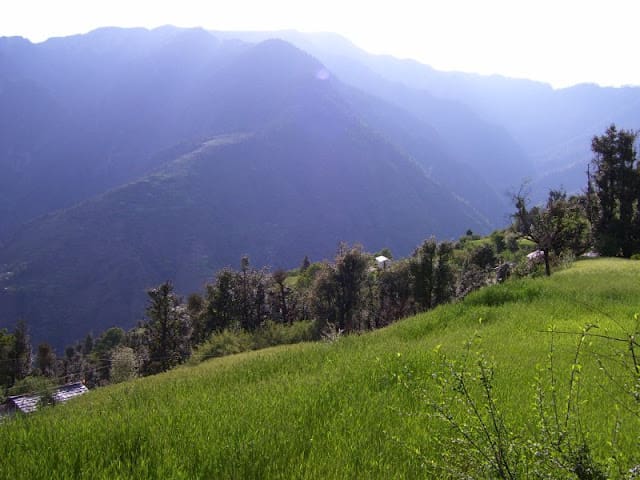 |
| Glowing fields of spring wheat, patrolled by Grey Bushchats and Brownish-flanked Bush Warblers, invite us to stay in Wan |
It’s a sad comment on how little aspects of natural history and the wilderness figure in our lives. For most, an understanding of natural history generally restricts itself to enumerating, describing, categorizing, interpreting and otherwise explaining the elements and workings of the natural world. But it’s more than that. It’s a re-examination of the natural world and humanities’ place within it. It is about the fundamental issues of life. It’s a celebration of wild nature. The study of natural history provides an antidote to solipsism. It requires courage to inquire of a parallel culture, to ponder another order. It requires a thinking mind to intuit how our fellow beings might illuminate some part of our own culture. It requires energy to gain a wholeness of outlook. Laziness of any hue has no place here.
Trekking then assumes a whole new dimension – as a nature enthusiast, one blends extensive field observation and an authentic and penetrating love for the natural world with a sense of independence, humanity, emotion, truth, wit. Only through personal participation in, and thoughtful observation of, wild nature, can one internalise the external. Inculcating a sensitivity to Nature must begin by exploiting one’s senses. It must be followed by developing the ability to see the continuity of nature in all its manifestations. Only then can we inculcate the joy that comes from contributing to her conservation.
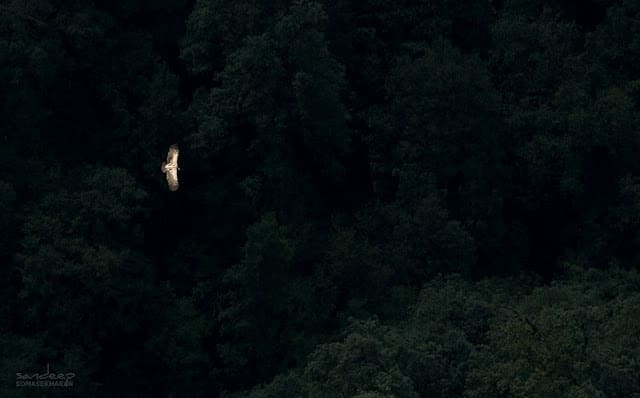 |
| A Himalayan Griffon sails over the dark forest |
That symbol of how fast a very common species can be made, through ignorance and neglect, to border on extinction, flies in to settle its magnificent vulture body on a nearby stump. Sahastra excitedly runs for his binoculars and urges his new friends to view the Himalayan Griffon – a magnificent bird with a precarious future. It is condemned along with its cousins to live a threatened existence.
Sunita soon sounds the tea bell. She barely functions without her dose of caffeine. We light up the gas and Devidutt supplies us with endless cups of tea. Sahastra, Satish and Bijoy who seem to have recovered mighty fast from the day’s exertions, express a keen desire to talk to their loved ones. They set off for the village, a half hour’s walk downhill, but not before Sahastra leans over to us (as we sit on the stone steps of our lodging, amidst an open bag of rations) and in his affable way tells us to please “ALSO COOK FOR THEM.” The ‘them’ of course, refers to the three young men from Canada. ‘Yeah sure,’ we smile. With our plans of cooking, changing and sleeping stymied, we make the most of our lot for the evening.
We cook two pressure-cooker-full quantities of khichdi, what else? And we make friends with the young men and have ourselves the time of our lives. To their credit, they are so full of the spirit of comity; they are gracious and courteous and interesting, and good-looking to boot, what more could one ask for!
 |
| The evening sun, shying behind the first of the deodars, welcomes us to Wan |
The sky still glows in the west. The stars begin to shine. For the first time on this trek the firmament is ablaze with brilliant fire. I am truly excited as I begin to read the crowded constellations. Star gazing possesses an unparalleled power to excite the human imagination. They seem so close, so intimate, yet so infinite; so near yet so unreachably far; the inky-black sky of night is yet so full of light. Once you master the major constellations, you are witness to an incredible display of patterns of order.
As a child my father had taught me to read Orion and the Ursa Major and how to locate the North Star. In the old days, he would spend months at sea plumbing the ocean depths with lead and line to later represent it cartographically – the charts being used worldwide by merchant shipping. Nowadays, with modern technology, the art of star gazing is no longer a requirement for a mariner. If we think about it, so much of our ability to do rational science is closely bound up with our ancestral experience of the sky. For the rest of the year, unless I make another trip into the mountains, the stars will glow only in recollection.
To cement the inevitability of the night and as testimony to their gratitude for our cooking dinner, our newly-acquired young friends shower us with goodwill and chocolates and bring out a suspicious looking bottle with a fingerful of whisky which we share in teaspoonfuls adding the welcome dram to our coffee. With a housewifely eye I note that the larger pressure-cooker of khichdi has been cleaned out with unembarrassed thoroughness.
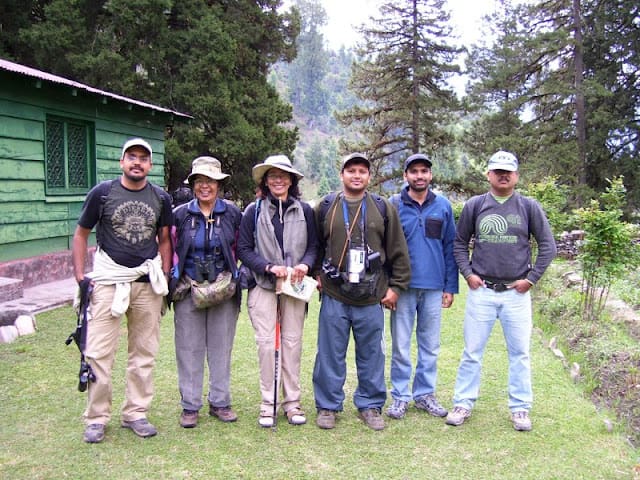 |
| Unembarrassed by the previous night’s dinner shenanigans, the group smiles for the camera |
As the tattered day finally departs, a Yellow-throated Marten makes its appearance. Its eyes burn like red coals. These omnivorous animals have sharp eyes, an acute sense of smell and if this one lives among the rafters of this old house, it has ample opportunities for finding food.
The evening chill turns to stone the once hot, gooey khichdi. Into the reaches of the night, our men arrive forlorn, with an implausible excuse – a long story of having got lost in the forest! Haven’t we women heard that one before? Sunita still insists they gorged on jalebis and pakoras, Bijoy’s hobbled knee notwithstanding! They seem stunned by the raucous noise of laughter. Without a word they swallow their gummy dinner and head silently for bed! So much for trekking to talk to loved ones. Whereas we, left-behind ladies, float on cloud nine!
Night has no trouble falling in these mountains – no artificial city lights to push it back. When night is banished in bright lights even midnight is deprived of its share of darkness. How many city-dwellers, I wonder, look skywards and never see the stars?
By Jennifer Nandi
Photographs: Beej and Sandeep Somasekharan
Previously in ‘Odyssey to Bedni Bugyal’
Part 1 | Part 2 | Part 3 | Part 4 | Part 5 | Part 6 | Part 7


